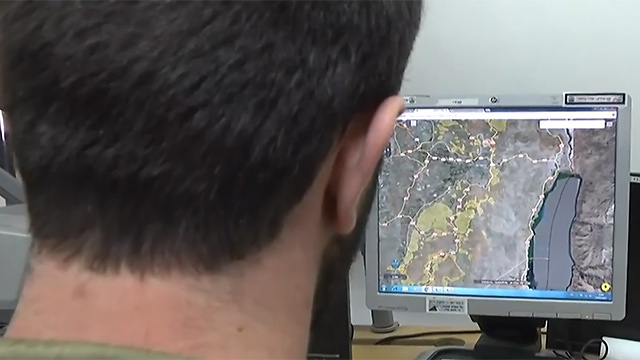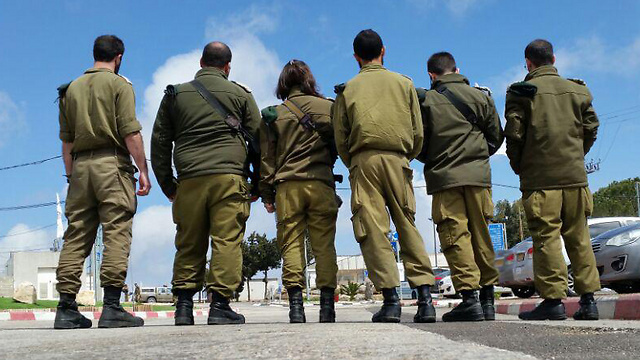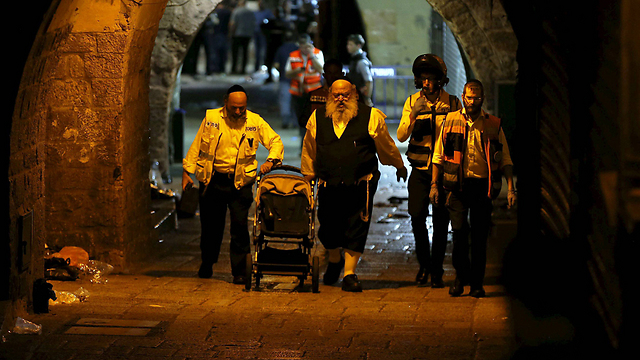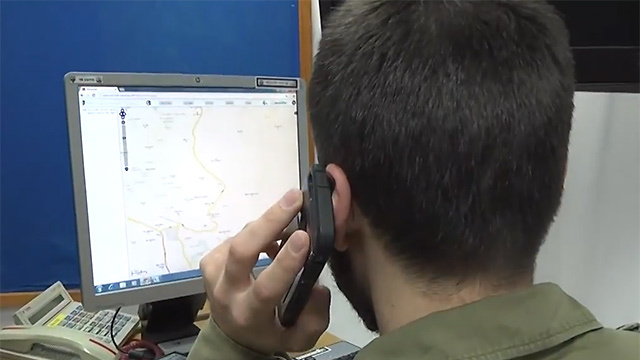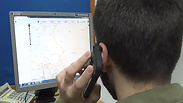
Intelligence soldier monitoring attacks
Photo: Eli Mendelbaum

How IDF’s intelligence hunted the ‘lone wolf’ terrorist
At the close of 2015, Israel faced an unprecedented challenge of thwarting a new kind of terror for which there could be little or no prior warning: Speaking to the senior intelligence officials, Ynet learns how the IDF placed an almost insurmountable obstacle in the way of prospective terrorist, clamped down on Hamas activity in the WB and restored normality to the country; 'After building profiles, we followed them and carry out arrests.'
Its January 2017 at 2am when Captain L., head of the warning division in the Judea and Samaria Division, is lying in bed when he receives a phone call: "Two terrorists intend to cross the fence in the direction of the heart of the country in order to carry out an immediate revenge attack,” the caller warns.
Cpt. L rushes to the situation room where he will preside over the deployment of the forces at his disposal in the designated area.
"The hours passed, the tension was enormous, the biggest fear was that they got passed me and then I would get a report about a terror attack," he recalls. "Shortly after 4pm, we hear that they have been caught. We could relax.”
The description by Cpt. L became a regular occurrence in the daily routines among intelligence personnel in the West Bank over the last 18 months.
The wave of terror forced those entrusted with the task of gathering paramount intelligence in real time to change their perceptions, to establish a completely new system, to operate within frameworks and arenas with which they were wholly unfamiliar beforehand. Perhaps more difficult for them was need to cope with failures, such as the fatal attack in Ofra last week.
"What really made the pin drop for us was the stabbing attack in the Old City in Jerusalem in October 2015 (in which Aharon Banita-Bennett, 21, and Rabbi Nehemia Lavi, 41, were murdered)," a senior intelligence official concludes.
"We realized then that the potential terrorist did not know he even know he was going to do what he did just two hours before the attack, and that's a big challenge."
Five officers from different quarters in the intelligence branch gave Ynet the opportunity to take a glimpse at the challenges facing the corps in the sector.
Major M., the Judea and Samaria intelligence officer, is in the area with the forces. She is often assigned the task of entering Palestinian villages. At the beginning of last month, M. was taken to the scene of the attack on the Mor Farm in the southern Hebron hills.
A terrorist stabbed an Israeli before himself being shot to death. "This is the kind of event, the characteristics of which are most concerning to us," M. asserted. "An isolated house that a terrorist managed to get into when the family was inside."
She added that "in this case the resourcefulness of the owner of the farm and his dog managed to neutralize the terrorist and prevent a greater disaster, but here we enter the picture. At the same time as the incident is taking place we are checking who the terrorist is and where he comes from. Within half an hour we were already in ad-Dhahiriya (a Palestinian city in the Hebron Governorate), and we quickly realized that this was a mentally ill young man, and was not orchestrated by an organization behind him."
In order to determine the typical profile of what has become commonly known as the ‘lone wolf terrorist,’ intelligence forces realized the necessity to combine forces which would enable them to deal not only with defense, but also to go on the offensive.
The cooperation between the intelligence bodies of the police, the Shin Bet and the IDF has undoubtedly yielded fruit. In addition, the IDF’s recent opening of an aerial surveillance unit aims to attack the terrorist who acts alone, imposing yet another obstacle in the way of their murderous intent.
"We understood immediately that deterrence must be restored and it should quickly be made harder for such a potential terrorist to become one," said Lt. S., head of one of the intelligence divisions.
“We understood that the terrorists had left the sector under our supervision and bought small arms. On a side note, their suits cost more than the weapons. That's why we started to take care of the weapons. The price of the Carlo rifle was NIS 2,000 a year ago, and today, after the raids on the lathes, its market price stands at NIS 7,000," he explained.
In addition to countering the weapons industry, the department also monitors incitement in social networks and within Palestinian cities. For example, S. explained how the authorities closed down printing houses that distributed leaflets and inciting content.
"We built profiles of participants in the demonstrations and then, using the social networks, we followed them and carry out arrests. We took everything that might indicate a desire or an early intention and turned it into specific intelligence."
But the work of intelligence personnel does not stop there, since much of the work of gathering of information continues even when there are no attacks.
The role of Captain N., head of the Area Division, is to gather information and intelligence about various officials and elements in the Palestinian Authority. Perhaps "The Big Brother" model best encapsulates the modus operandi implemented in the West Bank.
Put simply, the job is to stir things up on social networks, in places of residence, at work, in families and among those affiliated with terror.
"When an event occurs, the materials are transferred to the intelligence personnel who handle the incident. There are a lot of cases in which I collected and connected the information,” N. said.
Another field of intelligence focuses on the arena of Hamas infrastructure that is increasingly manifesting itself in the West Bank. The terrorist organization is seeking to expand its activities into Hebron, Nablus and Jenin.
However, according to Cpt. N who is charged leads operations to counter Hamas’s West Bank branch, Hamas is being persecuted by the IDF and feeling the heat.
"We hit them in the pocket. Every shop or person means that Hamas is being harmed financially. They develop methods to evade and challenge us," he explained, before recounting one of his men's successful operations in the Hamas arena.
"We received information about a store where Hamas activity was taking place, and we discovered that this was an seemingly innocuous bookstore. But it turned out that inside, behind the books, there were meetings taking place between Hamas members. The shop was instantly shut down and that caused the owner to lose a lot.”
Just a cursory glance at the figures which flow from the work of intelligence officers show that the operations thus far are a demonstrable success. In October 2015, for example, 59 attacks were committed by people from the West Bank. By contrast, in January 2016, the number dropped to 21, and in March this year, the data indicated that the number of attacks had significantly plummeted, dropping to a mere five attacks.
At the same time, these encouraging figures do little to assuage the severe distress among the terror victims and their families when attackers do succeed in bypassing the security apparatus.
According to the head of the unit charged with supplying warnings, Cpt L., "When you thwart a terror attack, there is massive sensation afterwards, but it is inside because no one knows about it. The media reports in the moment and then just moves on. But when you miss something, everyone hears about it and knows about it and also when you want to forget for a moment, the telephone reminds you that there is another story. There was another attack. This is a feeling that is hard to describe."
In addition to intelligence activities, special preparations continue during the holiday. A general closure was imposed on Monday at midnight on the West Bank and will continue until midnight this Monday at the conclusion of Passover.
During this period, the crossings in the Gaza Strip will also be shut. During the closure certain items will continue to flow through the crossings, such as humanitarian and medical aid, subject to the approval of the Coordinator of Government Activities in the Territories.
Against the background of the recent attack at the Ofra checkpoint where the late Sgt. Elchai Teharlev was murdered, the IDF will reinforce the West Bank area with additional battalions in order to secure the residents and travelers during the holiday.
Moreover, the IDF is expected to carry out counterterrorist activities in the villages in the coming days, with a renewed emphasis on the seizure of weapons and the arrest of wanted terrorists.
(Translated and edited by Alexander J. Apfel)














